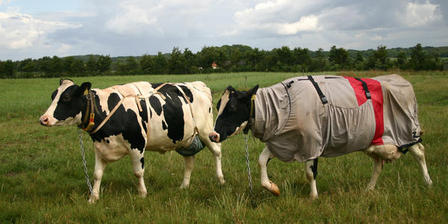Scientists are investigating what happens to cows� vitamin D3 production when the sun is not shining on them
Source: FarmingUK Newsdesk
Well-dressed cows are part of an experiment to examine the vitamin D3 production of cows so that winter milk may become just as nutritious as summer milk. Photo: Janne Hansen

It is with cows just as it is with people: vitamin D3 is only produced when the skin is exposed to the rays of the summer sun. In winter, when we bury ourselves in a thick layer of clothes and the sun is not strong enough, our vitamin D3 production declines and we have to increase our intake from other sources � by drinking milk, for example. But in winter, cows do not produce vitamin D3 either, so there is presumably not much to be gained from drinking their milk.
Scientists at the Faculty of Agricultural Sciences at Aarhus University will now investigate how the natural vitamin D3 content in milk can be optimised so that winter milk becomes just as nutritious as summer milk.
Part of the project consists of testing which parts of the cow�s body are important for vitamin D3 production. To this end, cows in the field have to a greater or lesser extent been robed. The most decorously clad cows are wearing a sort of dress that covers the entire back, sides and belly, including a cover for the udder � a sort of bra for cows. Others make do with either a bra or a dress and some wear none at all.
Before being put out on pasture the cows have been kept indoors all winter and have had no vitamin D3 supplement in their feed. This means that their vitamin D3 status is very low and that the increase taking place is an expression of their own production of vitamin D3.
- In organic herds you do not wish to add synthetic vitamins to the feed. Much work has therefore gone into sourcing feedstuffs for the cows that can cover their winter vitamin requirements when they are indoors. In this way it is possible to cover their vitamin A and E requirements, but there is no vitamin D3 in crops � this is only produced in mammals with the aid of sunlight, explains project scientist, Lone Hym�ller, who is in charge of this part of the project. Theoretically, most of the cows could have their vitamin D3 requirements covered by a supplement of fish oil, but this would taint the milk.
Cows in solarium
The cows in the experiment will be out in the field for three weeks. When it has been determined whereabouts on the cow�s body vitamin D3 is produced, the next step will be to expose the cows to UV light � a sort of artificial sunlight. For cows, this is nearly the same as a sunbed � but only nearly.
- The light in a solarium has a wavelength that is optimised to produce a tan in the shortest possible time. With the cows we use light that is optimised to produce vitamin D3, explains Lone Hym�ller.
Scientists hope to be able to find a solution whereby loose cattle housing can be equipped with light so that cows will be able to produce this vital vitamin all year round.
- The aim is for the cows to have a stable vitamin D3 status all year round, says Lone Hym�ller.
The experiment with covered cows is part of a larger research project on fat-soluble vitamins in cows, which is a collaboration with the National Food Institute at DTU Food and with the National Cattle Federation and is supported by the Ministry of Agriculture, Food and Fisheries via the Innovation Law.